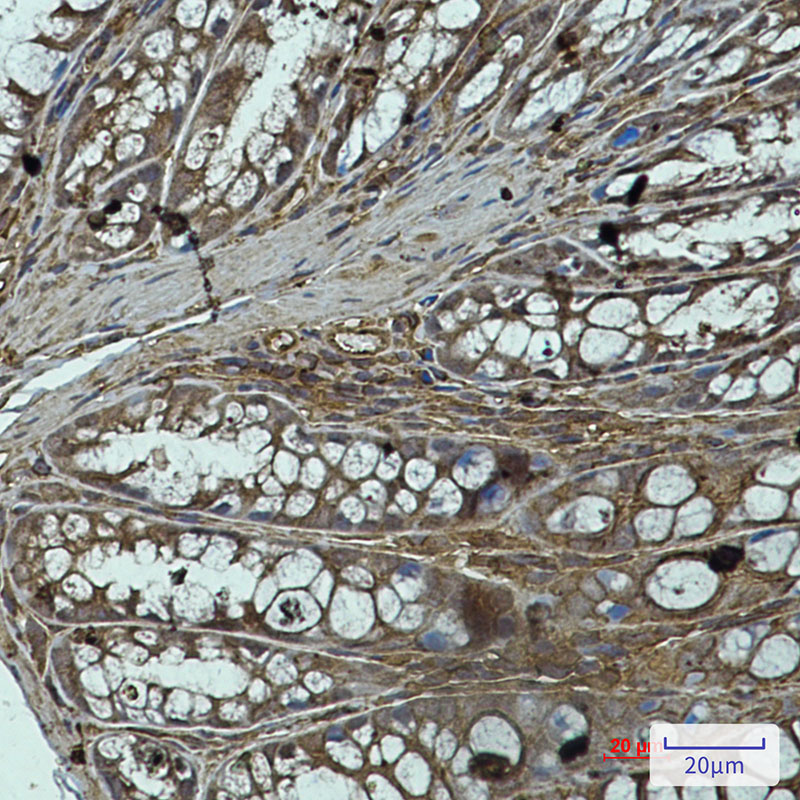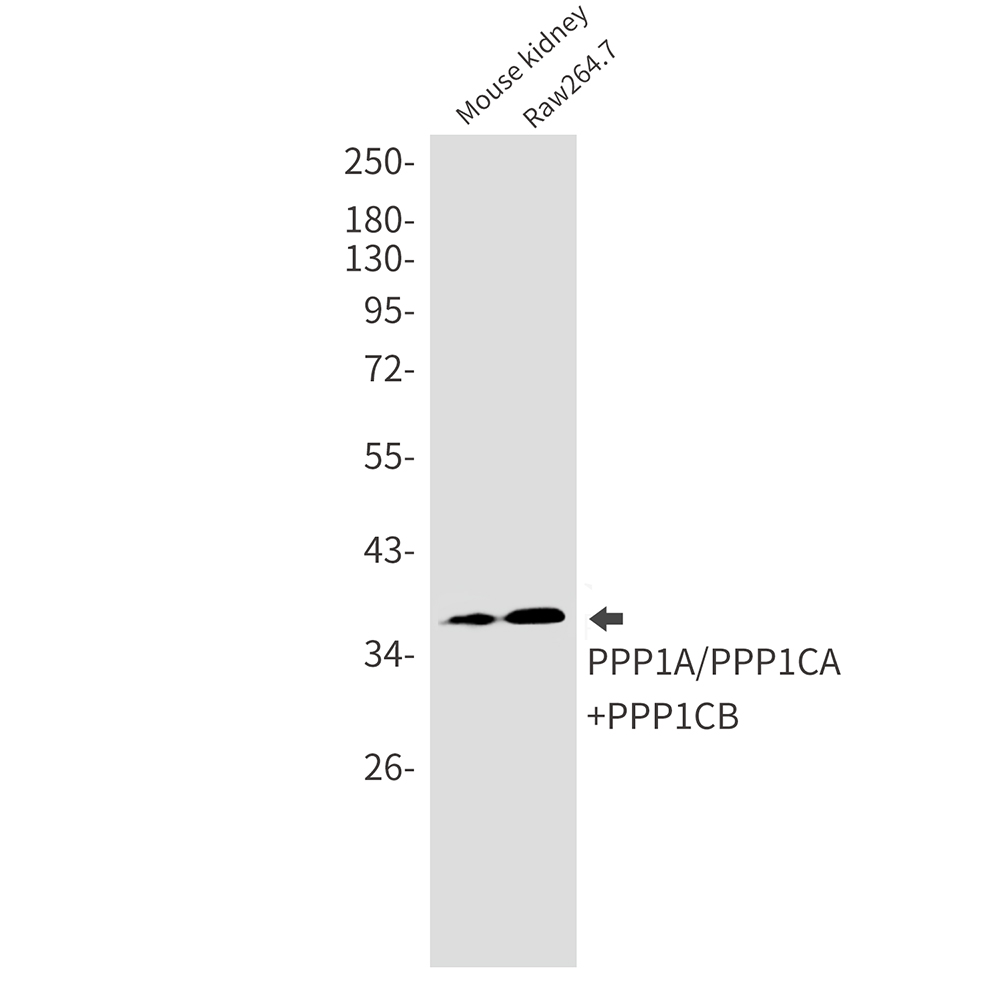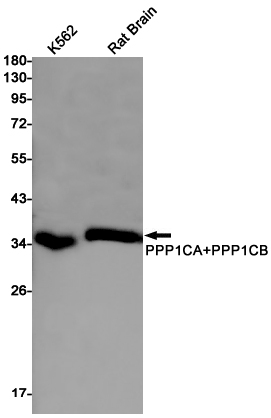PP1C alpha/beta Rabbit mAb
- SPECIFICATION
- CITATIONS
- PROTOCOLS
- BACKGROUND

Application
| WB, IHC-P, IP |
|---|---|
| Primary Accession | P62136 |
| Reactivity | Human, Mouse, Rat |
| Host | Rabbit |
| Clonality | Monoclonal Antibody |
| Calculated MW | 37512 Da |
| Gene ID | 5499 |
|---|---|
| Other Names | PPP1CA |
| Dilution | WB~~1/500-1/1000 IHC-P~~N/A IP~~1/20 |
| Format | 50mM Tris-Glycine(pH 7.4), 0.15M NaCl, 40%Glycerol, 0.01% sodium azide and 0.05% BSA. |
| Storage | Store at 4°C short term. Aliquot and store at -20°C long term. Avoid freeze/thaw cycles. |
| Name | PPP1CA |
|---|---|
| Synonyms | PPP1A |
| Function | Protein phosphatase that associates with over 200 regulatory proteins to form highly specific holoenzymes which dephosphorylate hundreds of biological targets (PubMed:28216226, PubMed:30158517, PubMed:35768504, PubMed:35830882, PubMed:35831509, PubMed:36175670, PubMed:39603239, PubMed:39603240). Protein phosphatase 1 (PP1) is essential for cell division, transcription elongation, and participates in the regulation of glycogen metabolism, muscle contractility and protein synthesis (PubMed:35768504, PubMed:35830882, PubMed:35831509, PubMed:36175670, PubMed:39603239, PubMed:39603240). Involved in regulation of ionic conductances and long-term synaptic plasticity. May play an important role in dephosphorylating substrates such as the postsynaptic density-associated Ca(2+)/calmodulin dependent protein kinase II. Catalytic component of the PNUTS-PP1 protein phosphatase complex, a protein phosphatase 1 (PP1) complex that promotes RNA polymerase II transcription pause-release, allowing transcription elongation: the PNUTS-PP1 complex mediates the release of RNA polymerase II from promoter-proximal region of genes by catalyzing dephosphorylation of proteins involved in transcription, such as AFF4, CDK9, MEPCE, INTS12, NCBP1, POLR2M/GDOWN1 and SUPT6H (PubMed:39603239, PubMed:39603240). The PNUTS-PP1 complex also regulates transcription termination by mediating dephosphorylation of SUPT5H in termination zones downstream of poly(A) sites, thereby promoting deceleration of RNA polymerase II transcription (PubMed:31677974). PNUTS-PP1 complex is also involved in the response to replication stress by mediating dephosphorylation of POLR2A at 'Ser-5' of the CTD, promoting RNA polymerase II degradation (PubMed:33264625). PNUTS-PP1 also plays a role in the control of chromatin structure and cell cycle progression during the transition from mitosis into interphase (PubMed:20516061). Regulates NEK2 function in terms of kinase activity and centrosome number and splitting, both in the presence and absence of radiation- induced DNA damage (PubMed:17283141). Regulator of neural tube and optic fissure closure, and enteric neural crest cell (ENCCs) migration during development (By similarity). In balance with CSNK1D and CSNK1E, determines the circadian period length, through the regulation of the speed and rhythmicity of PER1 and PER2 phosphorylation (PubMed:21712997). May dephosphorylate CSNK1D and CSNK1E (PubMed:21712997). Dephosphorylates the 'Ser-418' residue of FOXP3 in regulatory T-cells (Treg) from patients with rheumatoid arthritis, thereby inactivating FOXP3 and rendering Treg cells functionally defective (PubMed:23396208). Dephosphorylates CENPA (PubMed:25556658). Dephosphorylates the 'Ser-139' residue of ATG16L1 causing dissociation of ATG12-ATG5-ATG16L1 complex, thereby inhibiting autophagy (PubMed:26083323). Together with PPP1CC (PP1-gamma subunit), dephosphorylates IFIH1/MDA5 and RIG-I leading to their activation and a functional innate immune response (PubMed:23499489). Core component of the SHOC2-MRAS-PP1c (SMP) holophosphatase complex that regulates the MAPK pathway activation (PubMed:35768504, PubMed:35830882, PubMed:35831509, PubMed:36175670). The SMP complex specifically dephosphorylates the inhibitory phosphorylation at 'Ser-259' of RAF1 kinase, 'Ser-365' of BRAF kinase and 'Ser-214' of ARAF kinase, stimulating their kinase activities (PubMed:35768504, PubMed:35830882, PubMed:35831509, PubMed:36175670). The SMP complex enhances the dephosphorylation activity and substrate specificity of PP1c (PubMed:35768504, PubMed:36175670). |
| Cellular Location | Cytoplasm. Nucleus. Nucleus, nucleoplasm. Nucleus, nucleolus Note=Primarily nuclear and largely excluded from the nucleolus. Highly mobile in cells and can be relocalized through interaction with targeting subunits. NOM1 plays a role in targeting this protein to the nucleolus. In the presence of PPP1R8 relocalizes from the nucleus to nuclear speckles. Shuttles toward the cytosol during infection with VEEV (PubMed:29769351). |

Thousands of laboratories across the world have published research that depended on the performance of antibodies from Abcepta to advance their research. Check out links to articles that cite our products in major peer-reviewed journals, organized by research category.
info@abcepta.com, and receive a free "I Love Antibodies" mug.
Provided below are standard protocols that you may find useful for product applications.
If you have used an Abcepta product and would like to share how it has performed, please click on the "Submit Review" button and provide the requested information. Our staff will examine and post your review and contact you if needed.
If you have any additional inquiries please email technical services at tech@abcepta.com.













 Foundational characteristics of cancer include proliferation, angiogenesis, migration, evasion of apoptosis, and cellular immortality. Find key markers for these cellular processes and antibodies to detect them.
Foundational characteristics of cancer include proliferation, angiogenesis, migration, evasion of apoptosis, and cellular immortality. Find key markers for these cellular processes and antibodies to detect them. The SUMOplot™ Analysis Program predicts and scores sumoylation sites in your protein. SUMOylation is a post-translational modification involved in various cellular processes, such as nuclear-cytosolic transport, transcriptional regulation, apoptosis, protein stability, response to stress, and progression through the cell cycle.
The SUMOplot™ Analysis Program predicts and scores sumoylation sites in your protein. SUMOylation is a post-translational modification involved in various cellular processes, such as nuclear-cytosolic transport, transcriptional regulation, apoptosis, protein stability, response to stress, and progression through the cell cycle. The Autophagy Receptor Motif Plotter predicts and scores autophagy receptor binding sites in your protein. Identifying proteins connected to this pathway is critical to understanding the role of autophagy in physiological as well as pathological processes such as development, differentiation, neurodegenerative diseases, stress, infection, and cancer.
The Autophagy Receptor Motif Plotter predicts and scores autophagy receptor binding sites in your protein. Identifying proteins connected to this pathway is critical to understanding the role of autophagy in physiological as well as pathological processes such as development, differentiation, neurodegenerative diseases, stress, infection, and cancer.




